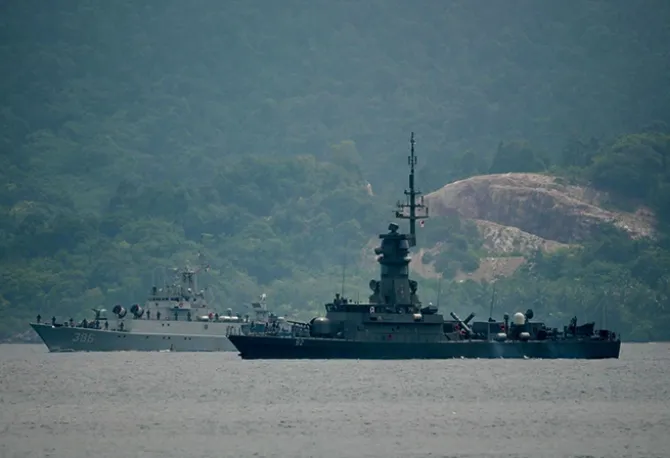-
CENTRES
Progammes & Centres
Location
Contrary to prevailing beliefs, the ASEAN exercise was aimed at highlighting ASEAN unity and initiating maritime security collaboration among its members

The ASEAN countries hosted their first joint naval exercise in Indonesia, the “ASEAN Solidarity Exercise (ASEX)”, in September 2023, from the island of Batam, south of Singapore, to an area near the Natuna Islands. The exercise included joint maritime patrol operations, search and rescue operations, and humanitarian and disaster relief according to a statement by Adm. Yudo Margono, the Indonesian military chief. The aim of the exercise was to boost “military ties among the ASEAN nations and enhance interoperability.” The drills also involved civilian groups working in humanitarian relief and disaster prevention. Previously, ASEAN member states have been a part of joint naval drills conducted by external players like the United States (US), Japan, Australia, the United Kingdom (UK), and India, but this is the first time that an exercise involving only the members of the regional bloc has taken place. Some view this as the bloc’s attempt at “signalling to China”, but the question that arises is whether this is truly how the ASEAN countries wish to portray this naval exercise.
The exercise included joint maritime patrol operations, search and rescue operations, and humanitarian and disaster relief according to a statement by Adm. Yudo Margono, the Indonesian military chief.
As mentioned, the exercise took place in the Natuna Sea, which is the disputed waters between China and Indonesia, since China’s infamous nine-dash line overlaps with a section of Indonesia’s Exclusive Economic Zone extending from the Natuna Islands. But the exercise, which was initially set to be held in the North Natuna Sea—which is the main zone of contention between the two countries—was later shifted to the South Natuna Islands, away from the disputed zone to avoid irking China. Currently, strong responses to China’s aggressive actions in the South China Sea, from Southeast Asian claimant countries like the Philippines and Vietnam, are visible. There are reports, for instance, of the Philippines filing a second case against China for environmental destruction in the South China Sea at the International Tribunal and the growing Philippines-US defence cooperation through the upgradation of the Enhanced Defence Cooperation Agreement (EDCA). Additionally, the visit to Hanoi by US President Biden last month and the evolution of the US-Vietnam bilateral relationship to a Comprehensive Strategic Partnership, primarily to boost a military partnership between the two, has also been widely reported. But at the same time, clearly, a strong response from ASEAN as a bloc to Chinese actions in the disputed waters still seems like a long shot. This was very clear from the Chairman’s statements released after the 43rd ASEAN Summit and the 18th East Asia Summit, both held on 7 September 2023. Both statements read, “Given the recent developments, there is a need to enhance mutual trust and confidence, exercise self-restraint in the conduct of activities that would increase tension, complicate or escalate disputes and affect peace and stability, and reaffirm the need to pursue peaceful resolution of disputes in accordance with the universally recognised principles of international law, including the 1982 UNCLOS.” Therefore, this clearly shows that when it comes to the South China Sea dispute, the ASEAN statements continue to be a carefully tailored one so as to not to dampen relations with China.
ASEAN’s soft response can also be to ensure the early conclusion of the COC, but the COC negotiations have been ongoing for quite some time now, and a soft response from ASEAN’s end has not expedited the process of the COC deliberations.
Therefore, even if countries like the Philippines and Vietnam, have changed their approach towards China and have adopted a harder stance towards the South China Sea dispute, it is unlikely that this could have any bearing on ASEAN’s position. The statement also mentions that the reading of the second draft of the Code of Conduct (COC) has been successfully concluded, but whether this would translate into the finalisation of the COC has not been specified. So, ASEAN’s soft response can also be to ensure the early conclusion of the COC, but the COC negotiations have been ongoing for quite some time now, and a soft response from ASEAN’s end has not expedited the process of the COC deliberations. Now would be a good time to rethink if such generic statements are in any way helping the ASEAN achieve its desired goal of making China enter into a legally binding COC. On the contrary, scholars have noted that the slow progress of the COC and ASEAN’s benign approach is forcing each ASEAN claimant state to pursue unilateral policies to uphold its sovereignty and economic rights. This is only throwing light on the divisions that exist within the ASEAN and is further undermining the “grouping’s centrality in the Indo-Pacific”. Just before the ASEAN Summit, China released its new 10-dashed line map and all the Southeast Asian claimant countries released statements rejecting this map, which did give the impression that a coordinated response or a harder response could be expected from the ASEAN. But, clearly these “coordinated rejections”, as some scholars have termed it, did not seem to affect the ASEAN position. Even the statements released after the Summit did not mention the new Chinese map. China has always preferred to enter into bilateral talks when it comes to discussing ways to resolve this dispute, instead of handling this at the multilateral platform of the ASEAN. So, these statements released by the claimant countries individually rejecting the 10-dashed line map—instead of a proper statement being released by the ASEAN—shows that even if ASEAN is aware of Chinese aggressive posturing, the need to not ruffle Chinese feathers so as to not sour relations with China is considered equally, if not more, important.
China has always preferred to enter into bilateral talks when it comes to discussing ways to resolve this dispute, instead of handling this at the multilateral platform of the ASEAN.
Indonesia has always played the role of the ‘primus inter pares’ or the ‘first among equals’ in the ASEAN and one of the ways to reinforce this role has been to convene many meetings to bring the member countries together. During its tenure as the chair of the ASEAN in 2023, Indonesia tried to convene many meetings and initiatives, which further solidifies this norm within the ASEAN. The ASEX also needs to be seen in this context. Indonesia, besides hosting this joint naval exercise, also hosted the first ever ASEAN Indo-Pacific Forum, released the ASEAN Maritime Outlook, and released a framework on Blue Economy. The goal for hosting this exercise appears to be two-pronged. The first goal was to put across the message to the global community that the unity within the ASEAN is still intact despite having differences of opinion on issues like Myanmar and the South China Sea. The second goal was, as some scholars have . It was not, in any way, meant to send a ‘signal or a strong message to China’. This exercise was a non-combatant one. Bt for this exercise to emerge as a significant one, scholars have rightly pointed out that there is a need to make this an annual endeavour and to institutionalise it so that this does not end up being a one-time event, and so that in the future, it can really “expand to full war drills involving the army, navy and air force” as expressed by the Indonesian military chief.
Premesha Saha is a Fellow with the Strategic Studies Programme at the Observer Research Foundation.
The views expressed above belong to the author(s). ORF research and analyses now available on Telegram! Click here to access our curated content — blogs, longforms and interviews.

Premesha Saha was a Fellow with ORF’s Strategic Studies Programme. Her research focuses on Southeast Asia, East Asia, Oceania and the emerging dynamics of the ...
Read More +